Conosciamo questa sensazione. Quel momento di sconforto quando il tuo sito va offline e non hai idea del perché. È uno degli errori più comuni di WordPress, ma anche uno dei più misteriosi. Non ti dice cosa c'è che non va, solo che qualcosa è rotto.
La buona notizia? È quasi sempre risolvibile. Avendo aiutato innumerevoli clienti, abbiamo avuto a che fare con questo errore parecchie volte.
In questa guida, ti illustreremo i passaggi esatti per rimettere in funzione il tuo sito. Segui semplicemente le istruzioni e tutto tornerà a funzionare in men che non si dica.
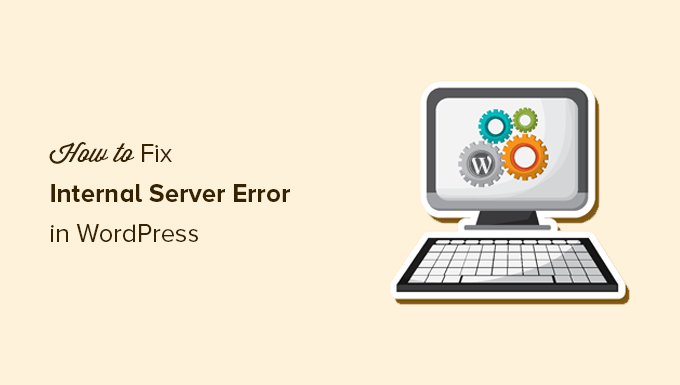
Ecco una rapida panoramica degli argomenti che tratteremo in questo articolo:
- Cos'è l'errore 500 Internal Server Error?
- Cosa causa l'errore Internal Server Error in WordPress?
- Risoluzione dell'errore 500 Internal Server Error in WordPress
- Svuota la cache di WordPress e del browser
- Verifica del file .htaccess corrotto
- Aumento del limite di memoria PHP
- Disattiva tutti i plugin di WordPress
- Passa a un tema WordPress predefinito
- Ricaricamento dei file principali
- Abilita i log di debug in WordPress
- Chiedi al tuo provider di hosting
- Tutorial video
Cos'è l'errore 500 Internal Server Error?
L'errore 500 Internal Server Error è come una porta chiusa a chiave senza chiave. Sai che qualcosa non va, ma non c'è nessun biglietto che spieghi cosa è successo.
Questo errore non è solo un problema di WordPress. Può apparire su qualsiasi sito web quando il server incontra un problema che non sa come gestire.
Il "500" nel messaggio è un codice di stato HTTP. Se lo cerchi, troverai una definizione vaga:
"Il codice di risposta 500 Internal Server Error indica che il server ha riscontrato una condizione imprevista che gli ha impedito di soddisfare la richiesta."
Non è molto utile, vero? È il modo del server per dire: “Qualcosa si è rotto, ma non sono sicuro di cosa.”
L'aspetto di questo errore dipende dalla configurazione del tuo hosting e dal browser web. Ecco un esempio di come appare su un server Apache:
Se il tuo sito funziona su Nginx, potrebbe apparire leggermente diverso. E se Google Chrome non riesce a caricare una pagina di errore corretta, vedrai qualcosa di simile a questo:
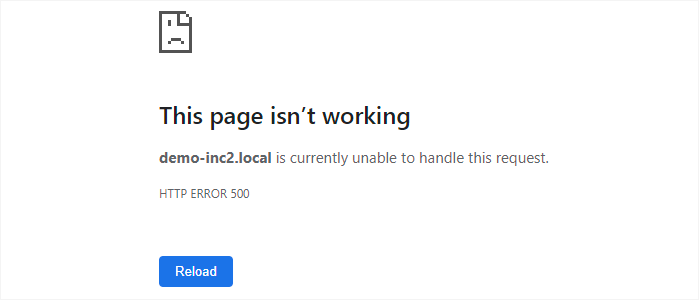
Per i principianti, questo può essere scoraggiante. Non c'è alcun messaggio che dica cosa è andato storto o come risolverlo.
È come chiedere a un meccanico di riparare la tua auto senza dirgli cosa è rotto. Dovrà controllare diverse parti finché non troverà il problema.
Dalla nostra esperienza, il modo migliore per risolverlo è procedere passo dopo passo. Ti guideremo attraverso le cause e le soluzioni più comuni in modo che tu possa far funzionare di nuovo il tuo sito.
Cosa causa l'errore Internal Server Error in WordPress?
L'errore interno del server in WordPress è come un puzzle con pezzi mancanti. Sai che qualcosa non va, ma il messaggio di errore non ti dice esattamente dov'è il problema.
Dalla nostra esperienza, il colpevole più comune è un file .htaccess corrotto. A volte, è un plugin che si comporta male o un tema che non è compatibile con la tua configurazione.
Altre volte, il tuo sito potrebbe raggiungere il limite di memoria PHP, causando il crash di WordPress. Anche file core corrotti possono innescare questo errore, lasciandoti bloccato senza preavviso.
In alcuni casi, l'errore appare solo quando si tenta di accedere all'area di amministrazione di WordPress, mentre il resto del tuo sito funziona normalmente. È come essere bloccati fuori dalla propria casa mentre gli ospiti possono ancora entrare dalla porta sul retro.
Ciò che rende questo errore complicato è che di solito si verifica prima che WordPress possa caricarsi correttamente. Ciò significa che il server non può raccogliere abbastanza dettagli per spiegare cosa è andato storto.
Se desideri approfondire come funziona WordPress dietro le quinte, consulta la nostra guida su come funziona WordPress sotto il cofano.
Ora, esaminiamo i passaggi di risoluzione dei problemi per rimettere in funzione il tuo sito.
Risoluzione dell'errore 500 Internal Server Error in WordPress
Prima di iniziare la risoluzione dei problemi, assicurati di avere a portata di mano un backup completo di WordPress del tuo sito web.
Se hai accesso all'area di amministrazione di WordPress, puoi utilizzare un plugin di backup di WordPress per creare un backup completo del tuo sito web.
Ti consigliamo di utilizzare Duplicator per gestire questo. Non solo ti aiuta a eseguire rapidamente il backup del tuo sito web, ma puoi anche archiviare i tuoi backup sul cloud e, soprattutto, puoi ripristinare il tuo sito web dal backup.
D'altra parte, se non hai accesso all'area di amministrazione di WordPress, puoi creare manualmente un backup di WordPress utilizzando phpMyAdmin e un client FTP.
Dopodiché, puoi seguire i passaggi seguenti per risolvere e correggere l'errore del server interno sul tuo sito web.
Svuota la cache di WordPress e del browser
I browser e i tuoi plugin di cache di WordPress possono talvolta memorizzare erroneamente una copia in cache di una pagina di errore.
Il modo più semplice per risolvere questo problema è prima svuotare la cache del browser.
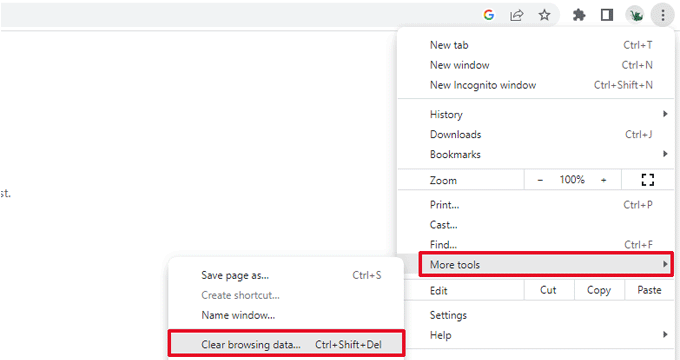
Dopodiché, se hai accesso all'area di amministrazione di WordPress del tuo sito web, puoi svuotare la cache di WordPress visitando la pagina delle impostazioni del tuo plugin di cache.
Per maggiori dettagli, consulta il nostro tutorial su come svuotare la cache di WordPress.
Verifica del file .htaccess corrotto
Il file .htaccess è un file di configurazione del server utilizzato da WordPress per impostare i reindirizzamenti.
Una delle cause più comuni dell'errore del server interno è il file .htaccess corrotto.
Il modo più semplice per risolvere questo problema è semplicemente visitare la pagina Impostazioni » Permalink nell'area di amministrazione di WordPress e quindi fare clic sul pulsante 'Salva modifiche' senza apportare alcuna modifica.
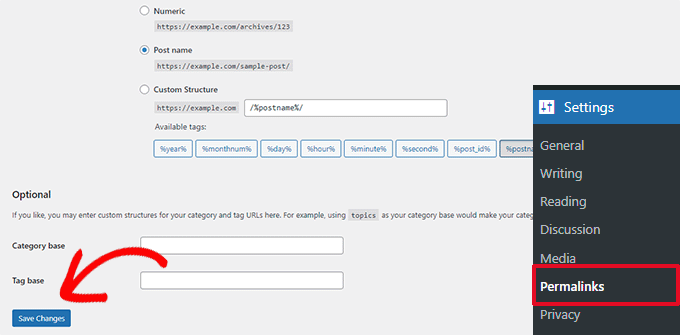
WordPress tenterà ora di aggiornare il tuo file .htaccess o di generarne uno nuovo. Ora puoi visitare il tuo sito web per vedere se questo ha risolto l'errore del server interno.
Se vedi ancora l'errore, devi assicurarti che WordPress sia stato in grado di generare o scrivere sul file .htaccess.
A volte, a causa delle autorizzazioni di file e directory, WordPress potrebbe non essere in grado di creare o scrivere sul tuo file .htaccess.
Ora puoi provare a sostituire manualmente il file .htaccess. Innanzitutto, devi accedere al tuo sito web utilizzando FTP o l'app File Manager nel pannello di controllo del tuo account di hosting.
Successivamente, devi rinominare il tuo file .htaccess in qualcosa come .htaccess_old. Questo ti permette di conservare il file come backup, ma WordPress non lo riconoscerà.
Per rinominare il file .htaccess, dovrai accedere al tuo sito tramite FTP o l'app File Manager nella dashboard cPanel del tuo account di hosting.
Una volta connesso, il file .htaccess si troverà nella stessa directory in cui vedrai cartelle come wp-content, wp-admin e wp-includes.
Fai semplicemente clic destro sul file .htaccess e rinominalo in .htaccess_old.
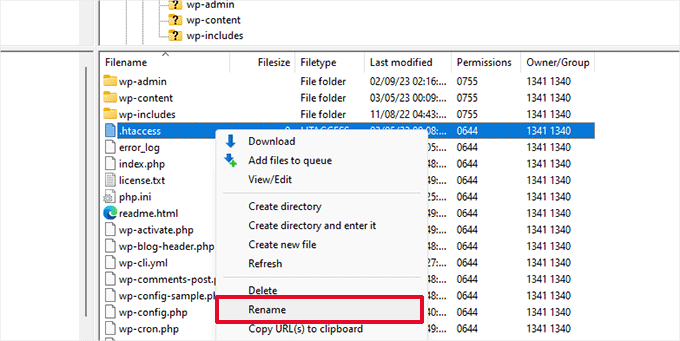
Successivamente, devi creare un nuovo file .htaccess.
All'interno della cartella principale del tuo sito, fai clic destro e seleziona l'opzione 'Crea nuovo file' nel tuo client FTP o nell'app File Manager.
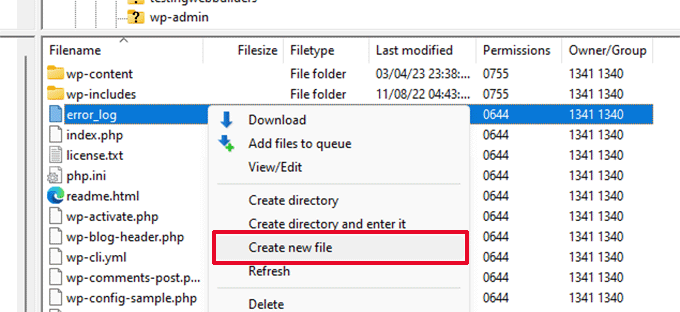
Nomina questo nuovo file .htaccess e fai clic su 'OK' per salvarlo.
Ora, questo file .htaccess è vuoto e devi aggiungere le regole di riscrittura predefinite di WordPress.
Fai semplicemente clic destro sul file e seleziona 'Visualizza/Modifica' nel tuo client FTP o nell'app File Manager.
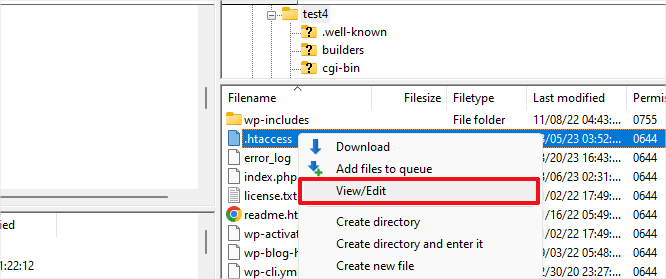
Il file vuoto si aprirà in un editor di testo semplice come Blocco note o TextEdit.
Ora, devi copiare e incollare il seguente codice al suo interno:
# BEGIN WordPress
<IfModule mod_rewrite.c>
RewriteEngine On
RewriteBase /
RewriteRule ^index.php$ - [L]
RewriteCond %{REQUEST_FILENAME} !-f
RewriteCond %{REQUEST_FILENAME} !-d
RewriteRule . /index.php [L]
</IfModule>
# END WordPress
Questo codice è l'insieme di regole predefinite utilizzate da WordPress. Non dimenticare di salvare le modifiche e caricare nuovamente il file sul server.
Ora puoi visitare il tuo sito web per vedere se questo ha risolto l'errore del server interno.
Se lo ha fatto, datti una pacca sulla spalla perché hai risolto l'errore del server interno.
Importante: Prima di procedere con altre attività, assicurati di andare alla pagina Impostazioni » Permalink nell'area di amministrazione di WordPress e fare clic sul pulsante Salva senza apportare modifiche. Questo rigenererà il file .htaccess per te con le regole di riscrittura corrette per garantire che le tue pagine dei post non restituiscano un errore 404.
Se la verifica del file .htaccess corrotto non ha funzionato per te, allora devi continuare a leggere questo articolo.
Aumento del limite di memoria PHP
A volte, l'errore del server interno può verificarsi se uno script consuma tutto il limite di memoria PHP.
Il modo più semplice per aumentare il limite di memoria PHP è modificando il file wp-config.php. Fai attenzione quando lo fai se sei un principiante. Devi seguire attentamente queste istruzioni perché anche piccoli errori nei file principali di WordPress possono danneggiare il tuo sito.
Per iniziare, connettiti semplicemente al tuo sito WordPress utilizzando un client FTP o l'app File Manager nel pannello di controllo del tuo account di hosting.
Troverai il file wp-config.php all'interno della cartella principale del tuo sito web. Fai clic destro su di esso e seleziona 'Scarica'. Questo garantirà che tu abbia un backup del file nel caso in cui qualcosa vada storto.
Una volta salvato, puoi fare clic destro su di esso e selezionare 'Visualizza/Modifica'.
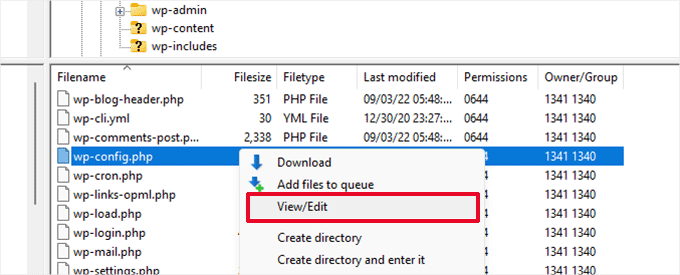
All'interno del file wp-config.php, devi aggiungere il seguente codice appena sopra la riga che dice, 'Questo è tutto, smetti di modificare! Buona pubblicazione':
define( 'WP_MEMORY_LIMIT', '256M' );
Per maggiori dettagli, consulta il nostro tutorial su come aumentare il limite di memoria PHP in WordPress.
Nota: Se 256M non risolve il problema, prova ad aumentarlo a 512M.
Se vedi l'errore del server interno solo quando provi ad accedere all'area amministrativa di WordPress o a caricare un'immagine nella tua wp-admin, allora dovresti aumentare il limite di memoria seguendo questi passaggi:
- Crea un file di testo vuoto sul tuo computer e chiamalo php.ini
- Incolla questo codice al suo interno: memory=256MB
- Salva il file
- Caricalo nella tua cartella /wp-admin/ usando FTP
Se aumentare il limite di memoria ha risolto il problema, allora hai risolto il problema solo temporaneamente. Devi ancora trovare la causa che sta esaurendo il tuo limite di memoria.
Questo potrebbe essere un plugin mal codificato o persino una funzione del tema. Ti consigliamo vivamente di chiedere alla tua azienda di hosting WordPress di controllare i log del server per aiutarti a trovare la diagnostica esatta.
Se aumentare il limite di memoria PHP non ha risolto il problema, è necessario un ulteriore troubleshooting.
Disattiva tutti i plugin di WordPress
Se nessuna delle soluzioni precedenti ha funzionato per te, allora questo errore è molto probabilmente causato da un plugin specifico installato sul tuo sito web.
È anche possibile che sia una combinazione di plugin che non vanno d'accordo tra loro.
Se riesci ad accedere all'area di amministrazione di WordPress del tuo sito web, puoi semplicemente andare alla pagina dei plugin e disattivare tutti i plugin di WordPress.
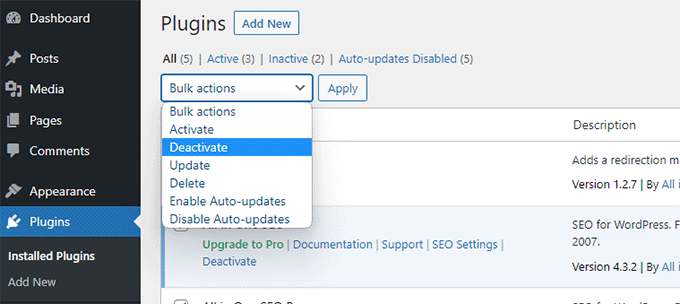
Tuttavia, se non riesci ad accedere all'area di amministrazione di WordPress, puoi disattivare tutti i plugin di WordPress utilizzando FTP.
Collega semplicemente il tuo sito web WordPress utilizzando un client FTP o l'app file manager sotto il pannello di controllo del tuo account di hosting.
Una volta connesso, naviga nella cartella /wp-content/ e rinomina la cartella plugins in plugins.deactivated.
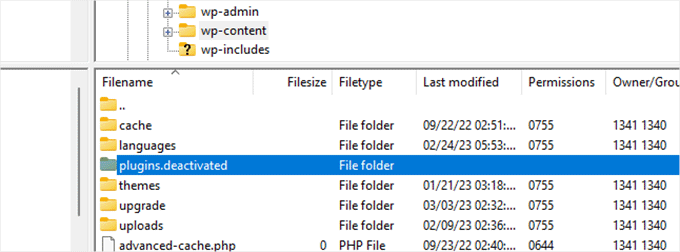
WordPress cerca i plugin nella cartella plugins. Se la cartella plugins non viene trovata, disattiverà automaticamente tutti i plugin.
Ora puoi provare a visitare il tuo sito web per vedere se questo ha risolto l'errore del server interno sul tuo sito web.
Per ripristinare tutti i tuoi plugin, puoi semplicemente rinominare la cartella 'plugins.deactivated' di nuovo in plugins.
I tuoi plugin verranno ora ripristinati, ma rimarranno disattivati.
Ora puoi attivare i plugin individualmente e visitare il tuo sito web per capire quale plugin sta causando l'errore del server interno.
Per maggiori dettagli, consulta la nostra guida su come disattivare tutti i plugin di WordPress senza wp-admin.
Se la disattivazione di tutti i plugin non ha risolto l'errore del server interno sul tuo sito web, continua a leggere.
Passa a un tema WordPress predefinito
Una possibile causa dell'errore interno del server potrebbe essere del codice nel tuo tema WordPress.
Per determinare se questo è il caso, devi cambiare il tuo tema con un tema predefinito di WordPress.
Se hai accesso all'area di amministrazione di WordPress, vai alla pagina Aspetto » Temi. Se hai già un tema predefinito installato, puoi semplicemente fare clic sul pulsante Attiva per cambiare tema.
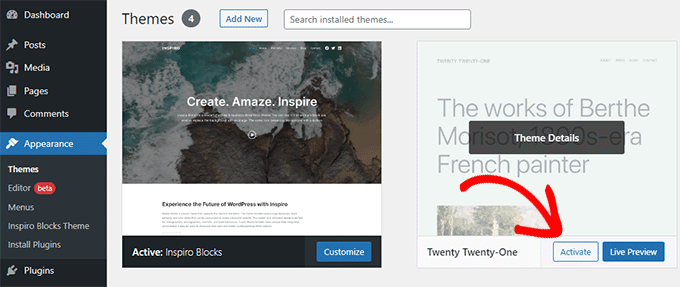
Se non hai un tema predefinito installato, puoi fare clic sul pulsante 'Aggiungi nuovo' in alto e installare un tema predefinito (Ventuno Ventitré, Ventuno Ventidue, e così via).
Se non hai accesso all'area di amministrazione di WordPress, puoi comunque passare a un tema predefinito.
Collega semplicemente il tuo sito web WordPress utilizzando un client FTP e naviga nella cartella /wp-content/.
Fai clic con il pulsante destro del mouse per selezionare la cartella dei temi e scaricala sul tuo computer come backup.
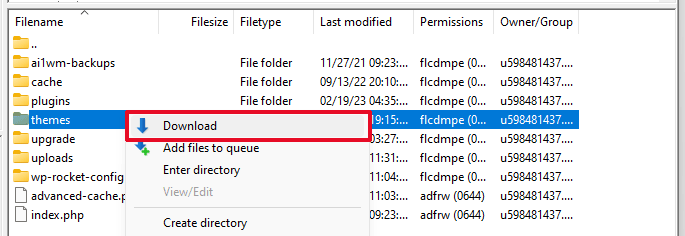
Successivamente, devi eliminare la cartella dei temi dal tuo sito web. Una volta eliminata, procedi e crea una nuova cartella dei temi.
La tua nuova cartella dei temi sarà completamente vuota, il che significa che al momento non hai temi WordPress installati.
Successivamente, devi visitare la directory dei temi di WordPress e scaricare un tema predefinito di WordPress sul tuo computer.
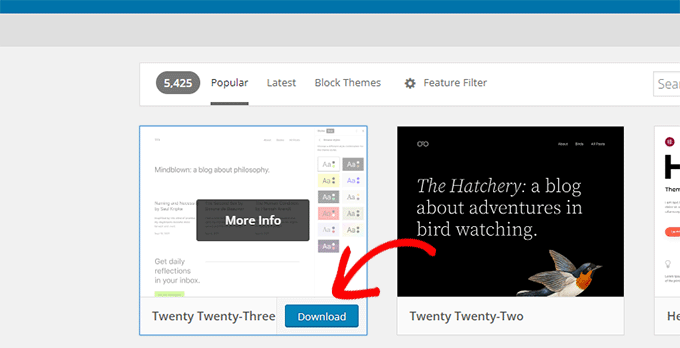
Il tuo browser scaricherà quindi il tema come file zip sul tuo computer.
Individua il file sul tuo computer e quindi decomprimilo. Gli utenti Windows possono decomprimere il file facendo clic con il pulsante destro del mouse su di esso e quindi selezionando 'Estrai tutto'. Gli utenti Mac possono fare doppio clic sul file zip per estrarlo.
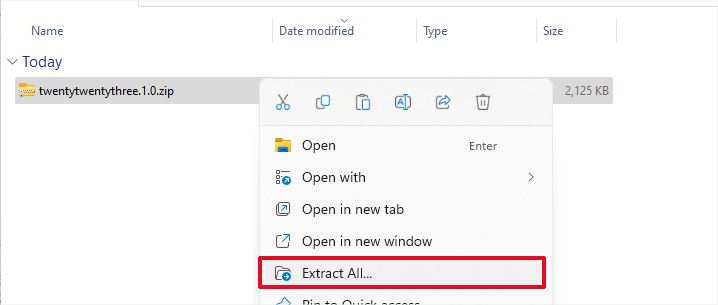
Ora vedrai una cartella contenente il tuo tema WordPress.
Torna al tuo client FTP o al File Manager e carica questa cartella nella cartella dei temi vuota.
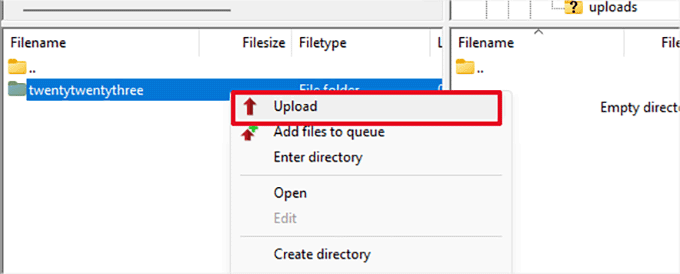
Una volta caricato, WordPress inizierà automaticamente a utilizzare il tema predefinito.
Ora puoi visitare il tuo sito web per vedere se questo ha risolto l'errore del server interno.
Se questo non funziona, puoi ricaricare i tuoi temi WordPress dal backup o tornare al tema che stavi utilizzando.
Non preoccuparti. Ci sono ancora alcune cose che puoi fare per correggere l'errore.
Ricaricamento dei file principali
Se le opzioni dei plugin e dei temi non hanno risolto l'errore del server interno, vale la pena ricaricare le cartelle /wp-admin/ e /wp-includes/ da un'installazione WordPress pulita.
Questo NON rimuoverà alcuna delle tue informazioni, ma potrebbe risolvere il problema nel caso in cui un file sia corrotto.
Per prima cosa, dovrai visitare il sito web WordPress.org e fare clic sul pulsante 'Download'.
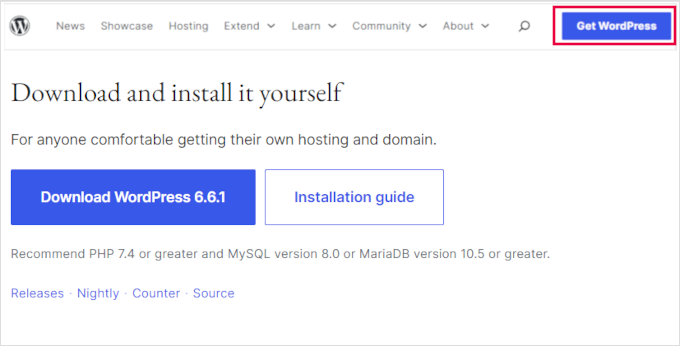
Questo scaricherà il file zip di WordPress sul tuo computer.
Procedi ed estrai il file zip. All'interno troverai una cartella wordpress.

Successivamente, devi connetterti al tuo sito web WordPress utilizzando un client FTP.
Una volta connesso, vai alla cartella principale del tuo sito web. È la cartella che contiene le cartelle wp-admin, wp-includes e wp-content al suo interno.
Nella colonna di sinistra, apri la cartella WordPress sul tuo computer.
Ora devi selezionare tutti i file all'interno della cartella wordpress e caricarli sul tuo sito web.
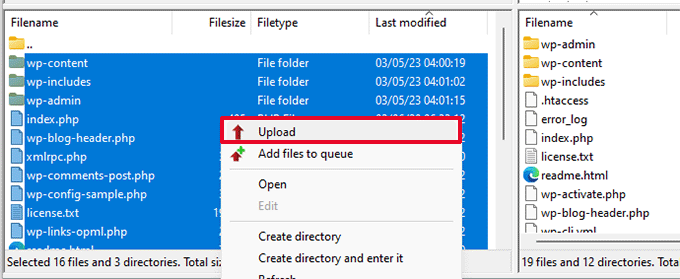
Il tuo client FTP trasferirà ora quelle cartelle sul tuo server.
Ti chiederà se desideri sovrascrivere i file. Seleziona 'Sovrascrivi', quindi seleziona 'Usa sempre questa azione' e seleziona la casella 'Applica solo alla coda corrente'.
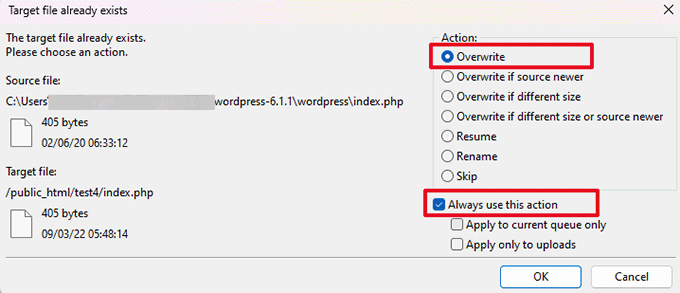
Il tuo client FTP sostituirà ora i tuoi vecchi file di WordPress con copie nuove e fresche.
Se i tuoi file di WordPress erano corrotti, questo passaggio risolverà l'errore del server interno per te.
Abilita i log di debug in WordPress
WordPress è dotato di un sistema integrato per mantenere i log per il debug.
Puoi attivarlo utilizzando il plugin WP Debugging. Per maggiori dettagli, consulta la nostra guida su come installare un plugin WordPress.
Una volta attivato, il plugin attiverà i log di debug sul tuo sito web WordPress.
Se non hai accesso all'area di amministrazione del tuo sito web WordPress, puoi attivare il debug aggiungendo il seguente codice al tuo file wp-config.php:
define( 'WP_DEBUG', true);
define( 'WP_DEBUG_LOG', true);
Una volta attivati i log di debug, puoi visualizzarli utilizzando un client FTP e navigando nella cartella /wp-content/.
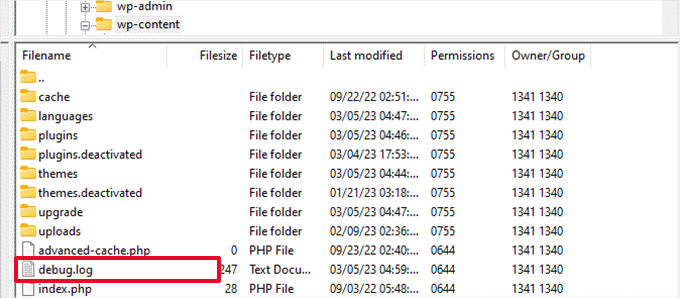
Puoi aprire il file di log di debug in un editor di testo, e ti mostrerà un elenco di errori e avvisi che si verificano sul tuo sito web.
Alcuni errori e avvisi possono essere incidenti innocui che potrebbero non richiedere correzioni. Tuttavia, se stai riscontrando un errore interno del server sul tuo sito web, questi potrebbero indicarti la giusta direzione.
Chiedi al tuo provider di hosting
Se tutti i metodi falliscono nel risolvere l'errore interno del server sul tuo sito web, allora è il momento di chiedere ulteriore aiuto.
Contatta il team di supporto del tuo web hosting, e saranno in grado di controllare i log del server e individuare la causa principale dell'errore.
Se desideri continuare a risolvere i problemi da solo, consulta la nostra guida definitiva alla risoluzione dei problemi di WordPress per principianti.
Tutorial video
Se ti è piaciuto questo articolo, iscriviti al nostro canale YouTube per tutorial video su WordPress. Puoi anche trovarci su Twitter e Facebook.





krzysiek
nel mio caso è stato semplice anche se ho passato qualche ora... Ho digitato male sql server. Sorprendentemente non ha generato una finestra con impostazioni di configurazione errate.
Staff di WPBeginner
Puoi scaricare il vecchio file .htaccess sul tuo computer come backup.
Ronaldo
Ciao!
Grazie per queste informazioni. Ho rinominato il file .htaccess e i miei siti sono attivi e funzionanti. Il mio server è GoDaddy.
La mia domanda è: posso cancellare il vecchio file .htaccess rinominato, perché ho chiamato molte volte GoDaddy per risolvere questo tipo di errore interno 500 dopo molte chiamate?
Grazie
brooke
grazie! questo ha salvato la giornata quando ho apportato la modifica .htaccess tramite ftp. posso respirare di nuovo... ; D
itechaleart
sto riscontrando questo errore 500 da 15 giorni su hosting godaddy. ho provato tutto quello che hai menzionato qui ma non sono riuscito a risolvere questo errore e ho anche chiamato godaddy per chiedere aiuto, ha detto che i siti funzionano bene sul nostro sito, controlla su un sistema diverso.
Now feeling hopeless and thinking to move another hosting provider…
per favore aiutami e suggeriscimi un'opzione migliore per l'hosting.
Grazie.
Silvia
Hello
i had the same problem with my website and went through all
your advices, without solving it. At the end i contacted my host and
they checked things for me, finding that some folders in the FTP had
CHMOD permissions different from 775. I didn’t do anything to cause
that, it just happened one day and i can’t get why. Anyway they fixed
the problem for me and said it’s easily manageable with ftp clients or
via their own file manager.
Just hoping it may be useful
pun
Il mio problema è risolto, grazie per questo tutorial, grazie mille
Arun
Ciao, sono una persona non tecnica e una principiante... La settimana scorsa ho avuto questo problema di errore del server interno. Tutto è iniziato con la restrizione del mio accesso amministrativo. Ma il sito funzionava bene. Ho passato più di 4,5 ore di notte con il provider di hosting (GoDaddy) con 3 persone diverse. (Questa era la terza volta in circa 4 giorni) Sono stati utili in una certa misura e hanno identificato il problema (la cartella wp-admin era mancante). Hanno sottolineato che avrei dovuto cancellarla poiché loro non avevano accesso (solo 2 giorni fa mi hanno modificato i file!!). Stavo accedendo dopo 7 o 8 mesi dalla creazione del sito. Comunque, ho chiesto se potevano ripristinare la cartella a una data precedente. Hanno rifiutato. La soluzione proposta era una tariffa di $150, dove avrebbero "tentato" di scoprire le modifiche ai file, ecc., ma senza garanzia. (Leggendo quanto sopra, presumo che avrebbero dovuto usare il contenuto sopra come domande/istruzioni nell'ordine scritto).
Comunque, da una delle discussioni (ho dimenticato il sito), ho scoperto che se si inserisce la cartella wp-admin (della versione installata), dovrebbe risolvere. Sì, ha funzionato per me... Ho attivato tutti i miei plugin (li avevano disattivati) e il sito funzionava. Ho anche aggiornato tutti i plugin e i temi che stavo usando/provando. il sito è online e funzionante!
deemyboy
@Levent Ultanur
Uno dei motivi per cui alcune persone potrebbero riscontrare un errore con .htaccess e non con le immagini è perché potrebbero caricarlo come binario.
In Filezilla (almeno) puoi impostare il tipo di trasferimento nella scheda del menu Trasferimento su:
auto
binary
ascii
Non sono sicuro, ma “auto” dovrebbe funzionare bene, ma se stai caricando solo testo, forse passa a “ascii” per quella sessione di caricamento, ma ricorda di tornare indietro.
Non ne sapevo nulla fino a ieri, quando tutte le immagini sul mio sito venivano corrotte quando le scaricavo in locale. Così ho cercato su Google e ho trovato un post che menzionava il tipo di trasferimento "binario" per le immagini, ma quando ho controllato ho scoperto che il tipo di trasferimento era impostato su "ascii" (per il testo – non so come, dato che non ricordo di averlo toccato!!) Quindi l'ho cambiato in "binario" e le mie immagini sono state scaricate perfettamente come prima.
Il motivo per cui dico che "auto" va bene è perché ho caricato e scaricato siti completi con un mix di immagini (png, jpeg, gif ecc.) e file di testo (.php, .html, .css) e non ho mai dovuto impostare individualmente ogni tipo di trasferimento o impostarlo su "ascii" e caricare solo file di testo, poi passare a binario e caricare solo immagini – Filezilla gestisce tutto automaticamente… normalmente!
Infatti, non ero affatto a conoscenza di questa impostazione e uso Filezilla da circa 2 o 3 anni!
Questo POTREBBE essere il problema, quindi chiedi ai tuoi clienti di controllare il tipo di trasferimento sulla loro applicazione FTP
Spero che aiuti!
deemyboy
Non hai enfatizzato abbastanza FORTEMENTE nella soluzione che sostituisce il core di WordPress che le persone dovrebbero
a) eseguire il backup della cartella wp-content <— questo è il tuo sito web (più il database wp che non c'entra in questo in quanto dovrebbe essere inalterato dalla sostituzione del core)
b) assicurarsi che quando sostituiscono wp-admin e wp-includes non prendano tutte e 3 le cartelle (cioè NON includere wp-content) quando caricano il nuovo core
Henrique
Grazie mille!
Deepanshu Kakkar
Grazie
Basha
Articolo Molto Molto Utile... Grazie mille
Guan
Errore interno del server 500 dopo l'attivazione dei plugin di WordPress
Warix
Thank you so much, it was problem in plugins
Kristian Frisk
Grazie per questo post. Ho imparato (a caro prezzo) quanto dolore un plugin difettoso possa causare a un sito WordPress.
F. Parisis
Grazie mille mille volte! È stato il posto migliore e unico dove ho trovato una soluzione, dopo un giorno di ricerca sul web.
Tom Grant
Buon lavoro - un aiuto enorme!
Anurag
A Big THUMBS up to this tutorial
Md.Zelal Hossain
Grazie mille per il bel tutorial..!!!!
Mulyadi Subali
Mi hai appena salvato la giornata. grazie!
imam
Ok grazie
Levent Ultanur
Ehi ragazzi e ragazze...
Quello che non capisco di questo errore è che POSSO caricare immagini senza ottenere l'errore http, ma il mio cliente riceve l'errore... Stesso server, stessi file... Perché oh perché... Qualcuno?
Kyle Hunzinger
Grazie, era il limite di memoria PHP!
Uwe
Grazie mille! Il .htaccess era il motivo!
Mark C.
Ciao ragazzi. Ottimo post! Uso questa pagina ogni volta che ricevo un errore del server interno.
Offrirei un passaggio aggiuntivo, tuttavia. In realtà, questo dovrebbe essere il primissimo passaggio prima che venga fatto qualsiasi altra cosa. Ovvero, verificare che non ci sia un problema con l'host web.
Ho seguito tutti i soliti passaggi stamattina sul sito di un cliente che è andato offline un'ora fa solo per scoprire, per puro caso, che PHP non funzionava sull'host. Un rapido controllo dei bollettini di servizio sul sito web dell'host web ha indicato che si era verificato un problema con quel particolare server. Quindi, tutto ciò che possiamo fare è aspettare che lo risolvano. (ci sono altri trucchi come cambiare il record A su un server diverso, ma questo è solo se il problema del server è a lungo termine.)
Detto questo, altre parti del server funzionano ancora, quindi è stato creato un indice.html rapido e grezzo solo in modo che i visitatori vedano qualcosa di carino invece di un errore.
È anche utile creare un file "test.php" che dimostri se PHP funziona o meno, e poi provare ad accedere a quel file ogni tanto. Quando il servizio viene ripristinato, elimina o rinomina l'index.html in modo che venga caricato l'index.php invece.
Ecco il mio codice test.php:
Test PHP
<?php echo ‘<p>Hello World</p>’; ?>
Spero davvero che questo aiuti qualcuno in una situazione simile. Tutto il meglio.
Bwana
Grazie per il tuo aiuto! Il mio sito mostrava solo l'errore "500 Internal Server Error" quando provavo a vedere quali plugin erano installati. Naturalmente, ho pensato che ci fosse un plugin che si comportava male. Dopo diversi tentativi di risolvere il problema rimuovendo tutti i plugin, ho trovato il tuo articolo. Il tuo "memory=64MB" in un php.ini pulito, posizionato in wp-admin, ha risolto il problema. Ora almeno posso lavorare con il sito per determinare cosa sta consumando tutta la RAM. Bel articolo!
Jorge Santos Velasco
Grazie mille!! è stato molto utile!!
Lakshay Sharma
Molte grazie per questo post, ha risolto il mio problema.
Denise O'Reilly
Sono bloccato fuori dal login di Wordpress da 2 settimane, poiché mi dice che il certificato di sicurezza non è verificato. Qualcuno può risolvere questo problema in modo che io possa accedere?
Staff di WPBeginner
A volte una configurazione errata del server viene corretta e l'errore non si ripresenta. In tal caso, dovresti contattare il tuo web host.
Jos
L'ho visto due volte. Il semplice ricaricamento della pagina lo ha risolto. Ma qualcosa potrebbe ancora essere sbagliato?
Matthew Newton
Grazie mille ragazzi, sospettavo fosse il .htaccess e questo lo ha confermato
Staff di WPBeginner
Dai un'occhiata alla nostra guida su come disattivare i plugin in WordPress quando non è possibile accedere all'area admin.
Jessica
Non riesco nemmeno ad accedere al mio pannello di amministrazione per provare a disattivare i plugin, ecc... Ho parlato con il mio provider di hosting e non hanno trovato alcun problema. Suggerimenti su cosa fare quando non si riesce nemmeno ad accedere al pannello di amministrazione?
Mitesh Raghwani
Grazie mille per il tuo aiuto. Una soluzione semplice per quello che sembrava un problema enorme.
Kailash Ghodke
I tried All Things which described above , but not worked for me
Is any other option like to install new wordpress on domain with all old posts ???
Il tuo aiuto è necessario, per favore aiuta a risolvere questo problema..!
Lidia Lewis
Grazie per questo articolo! Il mio file .htaccess era corrotto e ogni volta che lo rinominavo, ne appariva un altro duplicato! Il sito continuava a restituire messaggi di errore 500. Quello che non avevo capito era che dovevo salvare l'impostazione dei permalink in Wordpress per aggiornare il file. Spero che questo lo risolva definitivamente! Grazie mille.
Mark Brandson
Grazie mille. Il trucco del .htaccess ha funzionato. Mi hai salvato la vita!
Astrid
La disattivazione dei plug-in ha funzionato per me dopo l'ultimo aggiornamento di WP (8/4/14). Anche se penso che sia stato il rilevatore mobile di WP a entrare in conflitto con la mia cache W3 ad essere il colpevole.
Grazie mille, mi hai salvato la vita!
Il mio provider di hosting mi ha detto che avrei dovuto fare un backup (cosa che pensavo di aver fatto tramite un plugin) e che se avessi voluto un recupero e un backup avrei dovuto pagare 75,00 dollari. Davvero? Sono così deluso ma super felice di aver trovato questo articolo.
A proposito, siete i miei punti di riferimento quando si tratta di problemi facili da capire, passo dopo passo, con WP, plugin e simili. Abbiamo bisogno di voi qui - Continuate così. Apprezzo davvero i vostri sforzi.
Siete fantastici!
Subscribed and following
sangeetha menon
Ciao Syed,
Ho eliminato i file infetti perché continuavo a ricevere l'errore interno del server 500. Ora il provider di hosting mi ha chiesto di caricare i file freschi... Dato che non ho idea di come fare, ho chiesto ai provider di hosting di risolverlo.
Se devo farlo, quando carico nella web root devo sovrascrivere i file esistenti?
Devo fare anche la correzione del file htaccess? Aiuto per favore...
luka
Cambia semplicemente la versione PHP a 5.4 o superiore. Ha funzionato per me:)
Meg
O.M.G. Niente di meglio che svegliarsi con una pagina web persa. E sì, sono andato nel panico, ma per fortuna ho trovato il tuo post, ho fatto un respiro profondo e ho risolto tutto con il primo passo: file htaccess corrotto. GRAZIE! Devo davvero imparare di più su Wordpress.
Kevin
Thanks for the help, I was searching for quite a bit until I found your solution. I took a look at my .htaccess file and saw that it was corrupt, so I renamed it and it did the trick. Cheers
sherly
Con il tuo aiuto ho appena risolto il mio errore interno del server 500. Sono un principiante totale, quindi questo è molto utile!! Grazie!!
Derrick
Ciao Staff Editoriale,
Grazie mille!! Il miglior post rimedio per l'errore interno del server 500 che abbia mai trovato proprio quando ne avevo bisogno!!
Grazie mille!!
Nepal
Molto utile! Grazie mille...
Non ho fatto nulla da solo, ma ho contattato il mio provider di hosting... Vediamo quanto tempo impiegheranno a risolvere questo problema.
Anita Hunt
Thanks so much for your help
Keely
Thanks wpbeginner – the .htaccess fix worked for me
Olsi
Eliminare tutti i temi tramite File Manager lasciando solo 1 tema ha funzionato per me